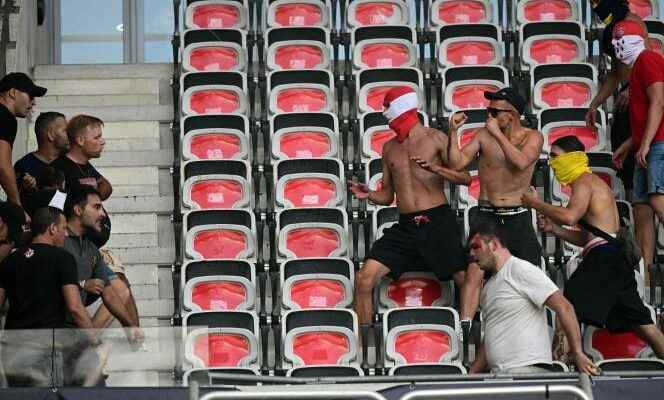Clashes between Nice supporters and Cologne ultras at the Allianz Riviera in Nice left at least thirty-two injured, including one seriously, just before the start of the Europa League Conference match between the teams of the two clubs. . The kick-off of the football match was given almost an hour late, and an investigation was opened to identify the perpetrators of the violence.
According to the historian and sociologist Sebastien Louisthe culture of hooliganism is deeply rooted in Germany, but this specialist in ultra movements welcomes the pragmatic approach practiced across the Rhine in the management of supporters.
Who are the German supporters involved in the violence Thursday at the Allianz Riviera in Nice?
They are mostly members of the Wilde Horde [« la horde sauvage »], a group that runs the Cologne fan stand, active since 1996. Alongside there are also other small groups. In Cologne, as throughout Germany, the Fan Szene [groupes de supporteurs] are quite complex.
The ultra movement arrived in Germany a quarter of a century ago – so later than in France – and only really took shape at the start of the 21st century. Until the turn of the 1990s, radical supporters in Germany were hooligans, responsible for very serious violence in the 1980s.
Subsequently, the ultra movement took over hooliganism, with a different political positioning. When hooligans rub shoulders with the extreme right, the majority of German ultras display more progressive, even anti-racist, anti-homophobic values, etc.
In Cologne, as elsewhere in Germany, hooligans of the old generation are sometimes joined by a new generation of hooligans. A German sociologist, Gunter A. Pilz, speaks of “hoolltras” – a synthesis of hooligan and ultras. We sometimes observe ultras who behave like hooligans. There are, even today, hooligans in almost all clubs in Germany, because it is a culture that is very rooted.
More than in England?
Without hesitation. Germany has one of the strongest hooligan cultures in Western Europe. Eastern clubs, for example Lokomotiv Leipzig – we are talking about the fourth division here – have major hooliganism problems. Even in seemingly unproblematic small German towns there are hooligan nuclei.
How to explain the presence in Nice of ultra Germans who would have been banned from stadiums in Germany?
I saw this info. You should know that there are some stadium bans which are national and others international. And depending on the country, people banned from stadiums must clock in [dans un commissariat avant les matchs] and others not. Legislation is different in Italy and France, for example. It is always complicated to enforce stadium bans at European level.
In my opinion, there was a lack of preparation upstream. It is obvious that this kind of match can attract supporters at risk, when we know the very strong friendship between the Supras d’Auteuil [un groupe d’ultras parisiens officiellement dissous, et dont des membres ont été aperçus parmi les supporteurs allemands jeudi à Nice] and the ultras of Cologne, knowing the rivalry between the Supras and the Niçois.
This complex geopolitics of the stands should be mastered by the authorities. There was a lack of discernment on the part of the authorities, particularly in the collection of information.
Are the Cologne ultras known to be fiery supporters?
The Fan Szene Cologne is one of the most problematic in western Germany, along with Eintracht Frankfurt. But the real problems of violence in the stadiums are often in the former East Germany: at Dynamo Dresden, Rostock, Magdeburg or even at Dynamo Berlin.
There are a lot of high-risk matches in Germany. In June, I went to see a play-off match to reach the fourth division, it was Eintracht Trier (Trier) against Stuttgart Kickers, in front of 6,000 spectators. There were at least 200 or 250 police officers mobilized for this match. Even small clubs like Eintracht Trier have hooligans. In Nice, there were 300 members of the police for a European Cup meeting…
Germany has had problems with violence for a very long time, except that it has different ways of dealing with them. The police devices are adequate, with spottersin particular, plainclothes police who are responsible for identifying groups at risk in advance.
German authorities have also focused on preventing violence in stadiums…
Absolutely. After the death of a fan during a match in Bremen in 1981, the German authorities set up Fan-Projekt, “fan projects”, through which clubs have the help of social workers, responsible for carrying out cultural projects with supporters, for example.
The Fan-Projekt are financed 33% by the Land, 33% by the club and 33% by the German Football Federation. It is one of the great successes of German supporterism. There are always two aspects in Germany: a very strong preventive aspect and, at the same time, a repressive aspect. A very pragmatic treatment that is lacking in France.
Is German fan management an example for other European leagues?
Germany has risky supporters at many clubs. And yet, for years, the Bundesliga has been setting stadium attendance records, even in the second and third divisions. I have seen games in the Dritte Liga with 28,000 spectators. Everyone can go to the stadium: the prices remain accessible, unlike in England.
On the other hand, the authorities’ approach to violence is much less anxiety-provoking and that’s really very interesting. The management of supporters by Germany is indeed, for me, a model to follow in Europe.
